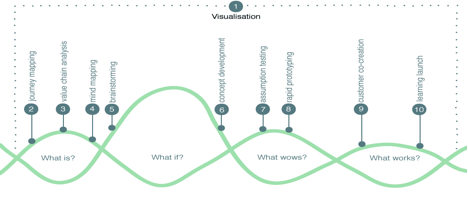Over the last 30 years most researchers have been converging on leadership, as Petriglieri (2014) states, “as the exercise of influence, as an activity, as something that the leader does to others. We haven’t paid enough attention to leading as something that the leader does on behalf of others.” The reflection on this belief has brought up only one side of the leadership relationship, from the leader to the follower, and we have been much less aware of the other side – from the follower to the leader.
In the leadership development theory the tendency is to design with the implicit goal in mind for homogeneous organisations. The actual business landscape shows that organisations are very different – they are precarious as well as very personal. Consequently, the leadership development needs to put on hold the silver bullet of rising up and distinguishing yourself. A new stance towards a different goal would keep people connected to themselves and others. The two connections that we need are a shared purpose and a direction to emerge. (Petriglieri, G. 2014)
Contemporary leaders like Mark Zuckerberg and Richard Branson are often depicted as charismatic business leaders. The first is considered as a genius able to keep his teams effective to bring Facebook forward. Branson with his unconventional attitude embodies a forward-looking vision to create something different in several industries. Such leaders propel great influence on their followers. They enliven people to act in certain ways with their enthusiasm, self-confidence and pure engagement in their business (Dawnson and Andriopoulus, 2014).
Several leadership researchers are looking beyond the concept of charisma and focusing on the idea of what they mean by ‘visionary leadership’. Robbins and Coulter (2002) argue that ‘visionary leaders create and articulate a realistic, credible, and attractive vision of the future that improves the present situation’.
In other words, it is about visions that revolutionise that way we think about business as much as transform people’s lives. Steve Jobs of Apple, Jeff Besoz of Amazon and Micheal Dell of Dell Computers are leading examples of leaders with clear and compelling visions that inspire and muster energy across their organisations.
What would leaders need to employ to act more like designers?
Three words: empathy, invention and iteration.
Four basic questions to map out the design process:
What is investigate the present;
What if envisions a potential future;
What vows makes some choices;
What works is guide into the actual marketplace.
Convergent and divergent thinking unfold by expanding the bands around each questions. There are ten tools that a design leader can use to address the four questions. At Procter & Gamble product developers spent a long time figuring out what the customers actually wanted. Design Thinking helped – instead of focusing on the detergents, they produced a better mop, the Swiffer. For the leader or manager, a positive conflict between shedding light on the unknown and protecting the best of the present is the way to go forward to reach new innovative models (Ogilvie and Liedtka, 2013).
By unlocking an individual creative potential it could spur a positive impact on the world. To embrace innovation at scale, leadership and grassroots need to blend to feed a collaborative culture. Mauro Porcini, the Chief Design Officer at PepsiCo, argues to gain creative confidence by framing five phases in corporations. ‘We are not creative‘: executive and employees say. This is the first phase with a reluctant attitude. The second phase is called ‘hidden rejection‘. Executive support fails to move from word to action. Mauro sees the third phase as ‘leap of faith‘ where higher roles show a clear initiative to invest resources that allow others to take risks and share their abilities, even if they fail. The fourth phase is ‘quest for confidence‘. Here the organisation enhances the creative resources in helping to achieve goals. Mauro calls the fifth ‘holistic awareness and integration‘. In this stage, teams regularly use creative tools to the challenge they face. The creative confidence is embedded in the company‘s DNA (Kelley, T. 2013).
These approaches shift the focus to humans rather than organisations. Therefore the understanding of value and the nature of relations between people and other people, between organisations of different kinds, are now considered as core to designing service. Service Design is playing a decisive role in drifting previous perceptions, by crafting boundaries around notions of creativity, pro-actively illustrating the meaningful social application of design, and connecting more people in the design process (Andrews, K. 2011).
If I let this crossing-view leapfrog toward the social entrepreneur profile, we see three pivotal tensions – Roger Martin and Sally Osberg outlined them beautifully in his or her endeavours:
Abhorrence and Appreciation
Expertise and Apprenticeship
Experimentation and Commitment
I want to share these ideas as I strongly believe in a positive shift as daily creative commitment in individuals who are the heart of any sort of organization.



Recent Comments